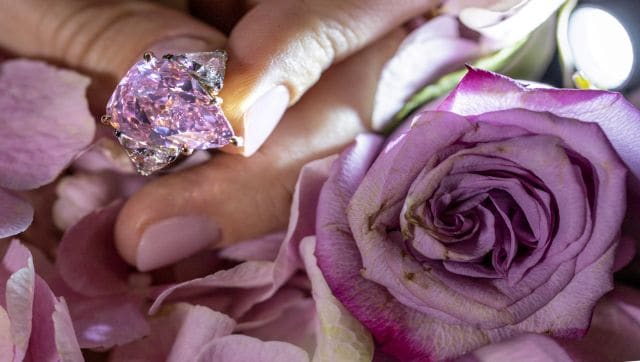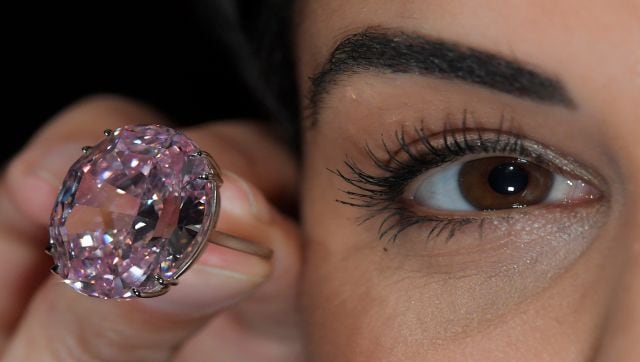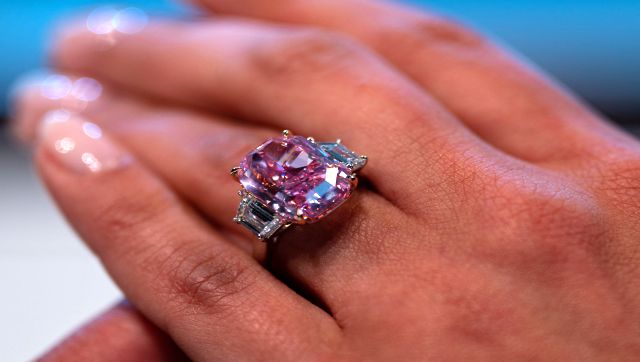There’s nothing better than a diamond. For many, they are the ultimate ‘I love you’ gift and jewellers will attest to the fact that the value of these rare gems is unmatchable. More so, if the gem is coloured – that is if they are pink, blue, green, violet, orange, or red in colour. For many, the beautiful and vibrant pink diamond is the mother of all diamonds. However, the mystery to how the stone acquired its colour was unknown – until now. Scientists on Tuesday revealed that they had unearthed the “missing ingredient” for pink diamonds and the discovery could help find more. Origin of pink diamonds Researchers in the United Kingdom, China, and Australia studied the pink gems emerging from the recently closed Argyle mine in the remote north-west of Australia. Notably, the Western Australia’s Argyle mine at its peak produced more coloured diamonds than anywhere else on Earth with more than 90 per cent of all the pink diamonds in the world coming from this one particular mine. Researchers in the study now published in the journal Nature Communications hypothesize that the breakup of an early supercontinent – called Nuna – lifted Argyle’s salmon-coloured stones from crushing depths toward Earth’s surface. “While the continent that would become Australia didn’t break up, the area where Argyle is situated was stretched, including along the scar, which created gaps in the Earth’s crust for magma to shoot up through to the surface, bringing with it pink diamonds,” said lead study author Dr Hugo Olierook, a research fellow at Curtin University’s John de Laeter Centre in Perth, Australia, in a news release. He further explained that the pink hue of Argyle’s most lavish diamonds was linked to the damage they underwent deep within the earth. According to the study, all the diamonds began colourless. But the immense tectonic pressure from the colliding continents altered the stones’ crystal structure and unlocked the colours within them. “The diamonds were forced to bend and twist. If they twisted just a little bit, they turned pink. Further twisting, made them become brown,” said Olierook as per a report by Scientific American. [caption id=“attachment_13147272” align=“alignnone” width=“640”] Pink diamonds have long been revered for their rarity and beauty. Some specimens of the highest grade have even sold for tens of millions of dollars. File image/Reuters[/caption] The study also reveals how these precious stones came to the Earth’s surface. The team found that the Argyle deposits were 1.3 billion years old, from a time when an ancient supercontinent, known as Nuna, was breaking up into fragments. As per the study, when the supercontinent Nuna was breaking up, it may have reopened the old juncture that the collided continents left behind, allowing diamond-bearing rocks to travel through this region to form the large diamond deposit. “Most diamond deposits have been found in the middle of ancient continents because their host volcanoes tend to be exposed at the surface for explorers to find,” Olierook said. “Argyle is at the suture of two of these ancient continents, and these edges are often covered by sand and soil, leaving the possibility that similar pink diamond-bearing volcanoes still sit undiscovered, including in Australia.” Think Pink! Few precious stones are as coveted as pink diamonds. Their great rarity has given them revered status in the world. Richard Revez, a gem expert at Florida-based Kravit Estate Department told the BBC, “When you talk about coloured diamonds, they’re already in the elite one per cent produced in the world. Pink diamonds are the one per cent of the one per cent.” And owing to their rarity and the prestige they hold, pink diamonds are also the most expensive across the world. Recently, the Eternal Pink, a 10.57-carat internally flawless fancy vivid purplish-pink diamond was put on the auction block by Sotheby’s with an estimated price of $35 million. Quig Bruning, head of Sotheby’s Jewellery, Americas at the time had said: “It’s the most vivid pink diamond to ever to come to market. This colour is the most beautiful and concentrated shade of pink in diamonds that I have ever seen.” [caption id=“attachment_13147292” align=“alignnone” width=“640”]
Pink diamonds have long been revered for their rarity and beauty. Some specimens of the highest grade have even sold for tens of millions of dollars. File image/Reuters[/caption] The study also reveals how these precious stones came to the Earth’s surface. The team found that the Argyle deposits were 1.3 billion years old, from a time when an ancient supercontinent, known as Nuna, was breaking up into fragments. As per the study, when the supercontinent Nuna was breaking up, it may have reopened the old juncture that the collided continents left behind, allowing diamond-bearing rocks to travel through this region to form the large diamond deposit. “Most diamond deposits have been found in the middle of ancient continents because their host volcanoes tend to be exposed at the surface for explorers to find,” Olierook said. “Argyle is at the suture of two of these ancient continents, and these edges are often covered by sand and soil, leaving the possibility that similar pink diamond-bearing volcanoes still sit undiscovered, including in Australia.” Think Pink! Few precious stones are as coveted as pink diamonds. Their great rarity has given them revered status in the world. Richard Revez, a gem expert at Florida-based Kravit Estate Department told the BBC, “When you talk about coloured diamonds, they’re already in the elite one per cent produced in the world. Pink diamonds are the one per cent of the one per cent.” And owing to their rarity and the prestige they hold, pink diamonds are also the most expensive across the world. Recently, the Eternal Pink, a 10.57-carat internally flawless fancy vivid purplish-pink diamond was put on the auction block by Sotheby’s with an estimated price of $35 million. Quig Bruning, head of Sotheby’s Jewellery, Americas at the time had said: “It’s the most vivid pink diamond to ever to come to market. This colour is the most beautiful and concentrated shade of pink in diamonds that I have ever seen.” [caption id=“attachment_13147292” align=“alignnone” width=“640”] A model poses with the 59.60-carat mixed cut diamond known as “The Pink Star”, the largest Internally Flawless Fancy Vivid Pink diamond ever graded by the Geological Institute of America (GIA). File image/Reuters[/caption] The most expensive diamond ever auctioned has also been a pink one. In 2017, Sotheby’s auctioned the 59.6-carat Pink Star diamond for a whopping for $71.2 million. Cut from a rough stone mined by the De Beers group in 1999, it first came up for auction in 2013, where it was purchased for $83 million by New York diamond cutter Isaac Wolf on behalf of a group of investors. However, it was returned to Sotheby’s after Wolf defaulted on the payment. It then returned on the auction block on 2017, this time in Hong Kong, where it sold to Chow Tai Fook Enterprises. It was renamed the CTF Pink Star Diamond, in honour of the company’s founder. Similarly, the Williamson Pink Star diamond, a 11.15-carat fancy vivid pink internally flawless stone, sold for $49.9 million last year. And now with the Argyle mine shutting down, there’s a higher premium on pink diamonds. As Arnaud Bastien, president and chief executive, Graff Diamonds, Asia, told South China Morning Post, “Prices have been going up for the past few years already and that is unlikely to change. The demand remains high for pink diamonds, especially on good quality pieces.” With inputs from agencies
A model poses with the 59.60-carat mixed cut diamond known as “The Pink Star”, the largest Internally Flawless Fancy Vivid Pink diamond ever graded by the Geological Institute of America (GIA). File image/Reuters[/caption] The most expensive diamond ever auctioned has also been a pink one. In 2017, Sotheby’s auctioned the 59.6-carat Pink Star diamond for a whopping for $71.2 million. Cut from a rough stone mined by the De Beers group in 1999, it first came up for auction in 2013, where it was purchased for $83 million by New York diamond cutter Isaac Wolf on behalf of a group of investors. However, it was returned to Sotheby’s after Wolf defaulted on the payment. It then returned on the auction block on 2017, this time in Hong Kong, where it sold to Chow Tai Fook Enterprises. It was renamed the CTF Pink Star Diamond, in honour of the company’s founder. Similarly, the Williamson Pink Star diamond, a 11.15-carat fancy vivid pink internally flawless stone, sold for $49.9 million last year. And now with the Argyle mine shutting down, there’s a higher premium on pink diamonds. As Arnaud Bastien, president and chief executive, Graff Diamonds, Asia, told South China Morning Post, “Prices have been going up for the past few years already and that is unlikely to change. The demand remains high for pink diamonds, especially on good quality pieces.” With inputs from agencies
Secret’s Out: The science of how pink diamonds get their colour, explained
FP Explainers
• September 22, 2023, 09:31:05 IST
Scientists have studied pink diamonds emerging from Western Australia’s Argyle Mine and found the breakup of a supercontinent called Nuna is possibly the reason why the precious gems received their colouring. The discovery could also reveal new deposits of the jewels
Advertisement
)
End of Article